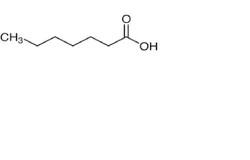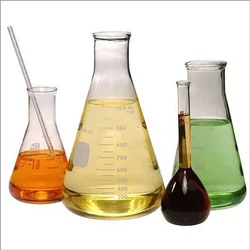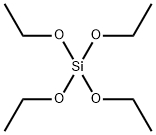Heptanoic acid
Synonym(s):Enanthic acid;Heptanoic acid;Oenanthic acid
- CAS NO.:111-14-8
- Empirical Formula: C7H14O2
- Molecular Weight: 130.18
- MDL number: MFCD00004426
- EINECS: 203-838-7
- SAFETY DATA SHEET (SDS)
- Update Date: 2025-12-17 09:50:05

What is Heptanoic acid?
Description
Heptanoic acid, also called enanthic acid, is an organic compound composed of a seven - carbon chain terminating in a carboxylic acid. It is an oily liquid with an unpleasant, rancid odor. It contributes to the odor of some rancid oils. It is slightly soluble in water, but very soluble in ethanol and ether.
Chemical properties
Heptanoic acid has a disagreeable rancid odor. The spectroscopically pure acid exhibits a faint tallow-like odor. Heptanoic acid may be prepared by oxidation of heptaldehyde with potassium permanganate in diluted sulfuric acid.
Occurrence
Reported as occurring naturally in calamus, hops, Acacia dealbata, and Japanese peppermint and violet leaves; its presence in rancid oils has been observed Also reported found in passion fruit, mandarin orange peel oil, guava, apple, banana, grapes, papaya, raspberry, strawberry, kiwi, baked potato, sauerkraut, tomato, breads, cheeses, butter, milk, fsh, fsh oil, meats, chicken fat, pork fat, hop oil, beer, cognac, brandy, rum, grape wines, sherry, whiskies, sake, peated malt, cocoa, coffee, tea, soy protein, peanuts, pecans, coconut, beans, mushroom, fenugreek, mango, fgs, licorice, corn oil, shrimps, scallops and other sources
The Uses of Heptanoic acid
There are two major uses for heptanoic acid. One is in vinyl plasticizers that are used primarily in the automotive market.This market is expected to grow 3 to 4% per year with GNP.The second is in synthetic lubricants, where heptanoic acid is used in polyol esters.The market for polyol esters is primarily for use in commercial and military jet turbine lubricants.There is a small market for these esters in the automotive lubricant area, but there has been limited acceptance of these products by automakers and the public.The growth of the polyol ester market is expected to track GNP, unless automakers change to support synthetics or unless there is an elevation of military activity.
The use of heptanoic acid in high-water metalworking fluids has grown in excess of 20% over the last several years.The amount of acid used in these products is small; therefore, a dramatic change from the traditional oil-based fluids would be required before there would be significant market impact.
The Uses of Heptanoic acid
Heptanoic acid is used as an organic building block for the synthesis of a variety of chemical compounds. It is involved in the esterification of steroids and used in the preparation of active pharmaceutical ingredients such as trenbolone enanthate, testosterone enanthate, drostanolone enanthate and methenolone enanthate. It is also used as an internal standard during gas chromatography analysis of the butyl esters of volatile acids. Its ester derivatives are used in the fragrance and flavor industries as well as cosmetics and industrial lubricants in aviation, refrigeration and automobile. It is used to prepare sodium heptanoate, which is used as a corrosion inhibitor.
Definition
ChEBI: A C7, straight-chain fatty acid that contributes to the odour of some rancid oils. Used in the preparation of esters for the fragrance industry, and as an additive in cigarettes.
Production Methods
The methyl ester of ricinoleic acid, obtained from castor bean oil is the main commercial precursor to heptanoic acid. It is hydrolyzed to the methyl ester of [[undecenoic acid]] and heptanal, which is then air oxidized to the carboxylic acid. Approximately 20,000 tons were consumed in Europe and US in 1980.
Ricinoleic acid is the main precursor to heptanoic acid. Heptanoic acid is used in the preparation of esters, such as ethyl heptanoate, which are used in fragrances and as artificial flavors. Heptanoic acid is used to esterify steroids in the preparation of drugs such as as testosterone enanthate, trenbolone enanthate, drostanolone enanthate and methenolone enanthate (Primobolan). It is also one of many additives in cigarettes.
Preparation
By oxidation of heptaldehyde with potassium permanganate in diluted sulfuric acid.
Taste threshold values
Taste characteristics at 5 ppm: waxy, cheesy, fruity, dirty and fatty.
Synthesis Reference(s)
Tetrahedron Letters, 21, p. 2181, 1980 DOI: 10.1016/S0040-4039(00)78992-1
The Journal of Organic Chemistry, 58, p. 4745, 1993 DOI: 10.1021/jo00069a047
General Description
A colorless liquid with a pungent odor. Less dense than water and poorly soluble in water. Hence floats on water. Very corrosive. Contact may likely burn skin, eyes, and mucous membranes. May be toxic by ingestion, inhalation and skin absorption. Flash point near 200°F.
Air & Water Reactions
Slightly soluble in water.
Reactivity Profile
Heptanoic acid reacts exothermically with bases. Can react, particularly if moist, with active metals to form gaseous hydrogen and a metal salt. Such reactions are slow if the acid remains dry. Corrodes or dissolves iron, steel, and aluminum parts and containers under ordinary conditions. Reacts with cyanide salts to generate gaseous hydrogen cyanide, particuarly if moist. May generate flammable and/or toxic gases with diazo compounds, dithiocarbamates, isocyanates, mercaptans, nitrides, and sulfides. Reacts with sulfites, nitrites, thiosulfates (to give H2S and SO3), dithionites (SO2), to generate flammable and/or toxic gases and heat. Reacts exothermically with carbonates and bicarbonates to generate a harmless gas (carbon dioxide). Can be oxidized exothermically by strong oxidizing agents and reduced exothermically by strong reducing agents. A wide variety of products is possible. May initiate polymerization reactions; may catalyze chemical reactions.
Hazard
Combustible.
Health Hazard
Harmful if swallowed, inhaled, or absorbed through skin. Extremely destructive to mucous membranes, upper respiratory tract, skin, and eyes. Inhalation may be fatal as a result of spasm, inflammation and edema of the larynx and bronchi, chemical pneumonitis, and pulmonary edema. Symptoms of exposure may include burning sensation, coughing, wheezing, laryngitis, shortness of breath, headache, nausea, and vomiting.
Fire Hazard
Heptanoic acid is probably combustible.
Properties of Heptanoic acid
| Melting point: | -10.5 °C (lit.) |
| Boiling point: | 223 °C (lit.) |
| Density | 0.918 g/mL at 25 °C (lit.) |
| vapor density | 4.5 (vs air) |
| vapor pressure | <0.1 mm Hg ( 20 °C) |
| refractive index | n |
| FEMA | 3348 | HEPTANOIC ACID |
| Flash point: | >230 °F |
| storage temp. | Store below +30°C. |
| solubility | water: soluble0.2419 g/100ml at 15°C |
| form | Powder |
| pka | 4.89(at 25℃) |
| color | White to off-white |
| Odor | at 1.00 % in propylene glycol. rancid sour cheesy sweat |
| explosive limit | 10.1% |
| Water Solubility | 0.24 g/100 mL (15 ºC) |
| Merck | 14,4660 |
| JECFA Number | 96 |
| BRN | 1744723 |
| Dielectric constant | 2.5(22℃) |
| Stability: | Stable. Incompatible with strong oxidizing agents, bases, reducing agents. Combustible. Protect from light. |
| CAS DataBase Reference | 111-14-8(CAS DataBase Reference) |
| NIST Chemistry Reference | Heptanoic acid(111-14-8) |
| EPA Substance Registry System | Heptanoic acid (111-14-8) |
Safety information for Heptanoic acid
| Signal word | Danger |
| Pictogram(s) |
 Corrosion Corrosives GHS05  Exclamation Mark Irritant GHS07 |
| GHS Hazard Statements |
H314:Skin corrosion/irritation H332:Acute toxicity,inhalation H335:Specific target organ toxicity, single exposure;Respiratory tract irritation |
| Precautionary Statement Codes |
P260:Do not breathe dust/fume/gas/mist/vapours/spray. P280:Wear protective gloves/protective clothing/eye protection/face protection. P303+P361+P353:IF ON SKIN (or hair): Remove/Take off Immediately all contaminated clothing. Rinse SKIN with water/shower. |
Computed Descriptors for Heptanoic acid
| InChIKey | MNWFXJYAOYHMED-UHFFFAOYSA-N |
Heptanoic acid manufacturer
Kavya Pharma
Triveni Interchem Private Limited (Group Of Triveni Chemicals)
New Products
4,4-Difluoropiperidine hydrochloride tert-butyl 9-methoxy-3-azaspiro[5.5]undecane-3-carboxylate Indole Methyl Resin N-Isopropylurea N,N-Dicyclohexylcarbodiimide(DCC) MELDRUMS ACID 5-METHYLISOXAZOLE-4-CARBOXYLIC ACID Magnessium Bis glycinate Zinc ascorbate 1-bromo-2-butyne 2-acetamidophenol 9(10H)-anthracenone Erythrosin B, 4-Piperidinopiperidine 2-((4-morpholinophenylamino) (methylthio) methylene) malononitrile 2,4-dihydroxybenzaldehyde 3-(4-morpholinophenylamino)-5-amino-1H-pyrazole-4-carbonitrile Methyl 2-methylquinoline-6-carboxylate 2,6-dichloro-4-nitropyridine 4-Bromo-2-chlorobenzonitrile 2-(benzylamino)acetic acid hydrochloride 4-(tert-Butoxycarbonylamino)but- 2-ynoic acid 3,4-dihydro-2H-benzo[b][1,4]dioxepine 1-Phenyl-1-cycloprppanecarboxylicacidRelated products of tetrahydrofuran
You may like
-
 Heptanoic acid 95.00% CAS 111-14-8View Details
Heptanoic acid 95.00% CAS 111-14-8View Details
111-14-8 -
 Heptanoic acid CAS 111-14-8View Details
Heptanoic acid CAS 111-14-8View Details
111-14-8 -
 Heptanoic acid 99% CAS 111-14-8View Details
Heptanoic acid 99% CAS 111-14-8View Details
111-14-8 -
 Heptanoic Acid CAS No.:111-14-8View Details
Heptanoic Acid CAS No.:111-14-8View Details
111-14-8 -
 Laboratory Heptanoic AcidView Details
Laboratory Heptanoic AcidView Details
111-14-8 -
 Heptanoic AcidView Details
Heptanoic AcidView Details
111-14-8 -
 Liquid Heptanoic AcidView Details
Liquid Heptanoic AcidView Details
111-14-8 -
 Liquid Heptanoic Acid, for Industrial, 75 MlView Details
Liquid Heptanoic Acid, for Industrial, 75 MlView Details
111-14-8








